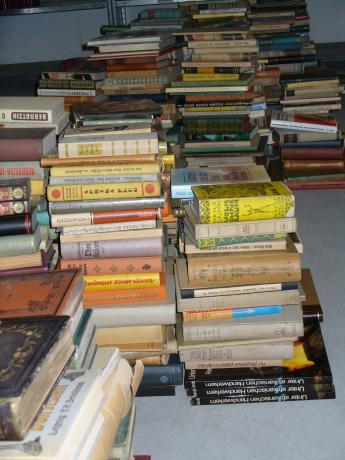News & Updates
Storing and Shelving Books

By Bon Summers
To those of us who plan to stay in this book business on-line this might be an article of worth. We know that 20,000 to 50,000 books can get out of hand where space is limited and locating a title can take more than five minutes.
Some of us, if we are honest with ourselves, might take 30 minutes to locate a book, so a proper management and planning system should be set up at the beginning. As the time taken extends, the less efficient your business becomes, especially when you work alone.
I must confess I was one of those new on-line dealers in 2001 (that’s 14 years ago now) when I went online and closed my brick-and-mortar store. I did not pay much attention to this main theme which I call Rule #1. Filing stock to a pre-planned system may take up more time than you would like in the first two years, but years later it will pay dividends as you will locate a title easily in five minutes.
I personally have just doubled my storage unit here in St. Augustine, Florida USA and find that I’m in ‘book heaven’. Now having an additional 532 sq. feet of storage and find my agenda is now to pay attention to that first rule.
Everyone thinks filing is simple but with so many varied sizes of books combining them with a booklet or pamphlet section, a miniature small book section of leather or cloth, a paperback mass market or a paperback/trade section, it can be that several sections of filing are needed.
You must know where your stock is!
A-to-Z filing is the accepted way, filed by author’s last name. Not much changes there for 90% of real book sellers . . . while Amazon and Alibris start their lists out with the title first. I cringe on that notion. But ABE still relies on the original system of A-Z by Author. Bless their little souls! How many of us have overlooked a book sitting right in front of us because we thought it was a red cover, not a beige cover with a red lettering, not a burgundy colour?
I remedied that problem years ago when I put in my description that very information I would need to ID a book on a line of books shelved with red, white and blue or black spines or white spines with various coloured ink lettering for the title and author.
A sure fire way to remedy this problem is to use the base colour of a spine, such as white and state if the title or authors name is in red lettering or black, etc. With 35 books in a row all the same colour this helps our eyes to adjust to such an advantage. I marvel now that I did not set that up in 2001.
White spine with black lettering is the chosen combo of colours for authors and publishers, red, orange, and yellow are ‘God sends’ for quick identifying, because they reach out grab you.
With over 500 more square feet to play with, I can now store by box of an author when I have over 10 titles or more. When you think Agatha Christie has 125 books, already that author defeats yours shelf management plans. It sure has started to work for me. I do not now have to go through lines and lines of shelves in the ‘Hs’ for example to find all of Hemingway’s or Higgins, or Highland’s - I just pull out a box so marked. Every bookseller has to do what they can to simplify their search. When you have three boxes of King’s (taking up a line of shelves for 30 books since his books are so thick) or of two boxes of chess books or three boxes of golf books it sure saves the eyeballs when a fast search is needed.
I still do not have enough shelf space to not resort to this method. When I see ten books on Charles Lindbergh and Anne Morrow Lindbergh I know that that pair of famous people are in the same marked box with Lindbergh printed on the outside of box . . .
Booklets now are being placed in their own clear plastic sleeves (designed for comics and magazines) and filed like a circulating file system once used in high schools in the ‘50s’ when I was a high school librarian. I found it then so easy to find booklets, etc. for students that I have incorporated an old tried and true method.
The reason for this is that many valuable booklets, such as Bach Flower Essence, booklets on local history, on foreign brochures, ancient maps or religious tracks can easily be set into several file cabinets and marked A-Z . . . and this is so much easier than setting them on a shelf and going through all of them each time a booklet/pamphlet is sold.
One suggestion is NOT to put that file cabinet directly on the floor but build it up on either concrete blocks, or wooden beams at least eight inches off the floor to save your back. Have a stool handy for easy searching. The older we get, these ‘little helpers’ are just that - ‘little helpers’.
Paperbacks are fantastic sellers here. The vintage paperbacks from 1920s to 1950s are money in the bank. I suggest each receive their own plastic bag and lay flat, not standing.
How many times have you experienced neck ache when making lengthy searches for titles stacked vertically - the accepted and proper way to stack books in any bookstore or library? That method is best for an open store when browsers are here and there and everywhere, pulling out their choices, by finger pulls at top and bottom of spine. But where a bookseller who stores their books in private quarters, for any length of time, it is better for the book to lay flat so it does not accidentally take on a slant . . .
Just for dealers who work on their own, these methods do speed the search process and save
hundreds of hours in every year.
It is such a delightful event when a book is found in five minutes, processed in another ten minutes, wrapped in five minutes, and out to the mail box in another five!
Remember at all times that ‘books breed’ and within a year you will find that you will need another 500 sq. feet of storage!
***
Published in Sheppard’s Confidential, presented here by permission of Bon Summers, Ancient City Booksellers, St. Augustine, Florida USA, and Sheppard’s Confidential. Pictures: Barbara van Benthem


